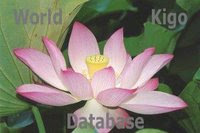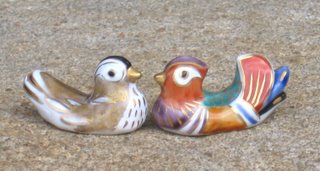[ . BACK to DARUMA MUSEUM TOP . ]
:::::::::::::::::::::::::::::::::::::::::::::::::::::::::::::::::::::::::::::::::::::::::::::::::::::
Katana - Daruma and the Japanese Sword
日本刀とだるま― 武芸散歩

:::::::::::::::::::::::::::::::::::::::::::::::::::::::::::::::::::::::::::::::::::::::::::::::::::::
A sword together with a mirror (yata no kagami) and a comma-shaped jade jewel (yasakani no magatama) is one of the three Imperial regalia of Japan.
The Imperial Sword of the Billowing Clouds.

"The sword Susanooh discovered in the tail of the slain eight-headed dragon (orochi) and gave to the gods was eventually given to
Ninigi (great grandfather of Emperor Jinmu, the first Japanese emperor), a grandson of Amaterasu the sun goddess, when he came down to earth. The sword is one of the three divine articles that are part of the Japanese Imperial regalia, but it was lost in the 12th century. The sword's name is "Ama-no-Murakumo-no-Tsurugi" (sword of heavenly gathering of clouds), and it is also known as "Kusanagi-no-Tsurugi" (grass cutting two-edged sword) when it was used by Yamato Takeru to cut grass to make an escape route when he was surrounded by fire in one of the Ainu subjugation campaigns. So, both Murakumo and Kusanagi refer to the same thing, the sword of Orochi, the Dragon-King of the Sea.
This sword could only be wielded by the Emperor of Japan."
The close connection of the Imperial power with the heavenly sword maybe explaines why the Japanese have such a special veneration for swords, later to be called "The soul of the Samurai" and always handled with great respect. We will explore the religious aspect of the sword in Part 1 and the more materialistic one in Part 2.
八咫鏡(ヤタノカガミ), 草薙の剣(クサナギノツルギ)、八尺瓊勾玉(ヤサカニノマガタマ) - 剣は三種の神器として昔から日本人にとって大事なものでした。武士の魂とも言われているほど侍の大事な道具でした。パート1では、宗教で見られる刀、パート2では、具体的に刀の話をすすめます。
http://inoues.net/yamataikoku/3shu/3shu_jingi.html
Read more about the legendary AMA-no-MURAKUMO-no-TSURUGI, the Sword of the Billowing Clouds on the following HP, which will be introduced in detail in Part 2.
http://www.sho-shin.com/yam1.htm
. Ninigi ニニギ and Sakuyahime 花咲屋姫命 .
:::::::::::::::::::::::::::::::::::::::::::::::::::::::::::::::::::::::::::::::::::::::::::::::::::::
. Futsumitama 布都御魂 Futsu no mitama .
The personification of a divine sword.
Futsumitama no tsurugi 韴霊剣、布都御魂剣(ふつみたまのつるぎ)
Sajifutsu no kami 佐士布都神(さじふつのかみ)
Mikafutsunokami 甕布都神(みかふつのかみ)
:::::::::::::::::::::::::::::::::::::::::::::::::::::::::::::::::::::::::::::::::::::::::::::::::::::
The Buddhist Sword of Wisdom 知剣 Chiken
In Buddhism, we have a more philosophical form, the Sword of Wisdom. It is carried by Monju Bosatsu and the Wisdom King Fudoo (see below).
 Monju Bosatsu (Manjushri Bodhisattva) 文殊菩薩
Monju Bosatsu (Manjushri Bodhisattva) 文殊菩薩
In his left hand he holds a sutra by which he dispenses wisdom to people, and in his right hand holds a sword for cutting off delusion. He sometimes rides on a lion, which is called the king of a hundred animals, and this expresses how he lives grandly with a powerful and correct wisdom.
"If three people are together, the Wisdom of Monju emerges" is a common saying in Japan which showes the strong connection with Monju and Wisdom.
Legend says that Monju was an Indian monk, born after the death of Shakyamuni. He reached the status of Bodhisattva through his serious ascetic studies. His religious dispute with the lay Buddhist Vimalakirti is reported in a famous sutra, Yuimakyoo.
Manjushri is very popular in Tibet, Northern China and Mongolia. The name of the region "Manjuria" might be taken from a deformed prononciation of "Manjushri".
source://www.shingon.org/

Chiken (知剣, Buddism sword of wisdom)
on a sword at
Yahiko Shrine (弥彦神社), Niigata
source : Taisaku Nogi
.................................................................................
If you repeat the
Holy Mantra of Monju, On A Rahashanoo, you might gain the wisdom of Monju, if you practise seriously.

オン ア ラハシャノウ
オン アラハシャノウ
この真言(五字文殊法)
:::::::::::::::::::::::::::::::::::::::::::::::::::::::::::::::::::::::::::::::::::::::::::::::::::::
The Wisdom King Fudoo Myoo-oo and
the Sword Kurikara
不動明王と倶利伽羅不動剣
The unmovable Fudoo (Acala Vidyaaraaja) is one of the Wisdom Kings (Myoo-oo). He is usually depicted in a very wrathful way. He is a typical Japanese deity, introduced by Kooboo Daishi about 806 and soon became a special protector of the Mountain Ascetics (yamabushi). An impressive waterfall is considered the personification of Fudoo, for example the Great Waterfall at Nachi, which we met in the story about Kumano.
Fudoo is portrayed holding a two-edged sword with a three-pronged hilt in his right hand and a coiled rope in his left hand. With this sword of wisdom, Fudoo cuts through deluded and ignorant minds and with the rope he binds those who are ruled by their violent passions and emotions.
http://www.shingon.org/deities/jusanbutsu/fudo.html
Kurikara Fudo is another personification of this deity, this time in the form of a Dragon-Sword. The Dargon King Kurikara (Sanskrit: Kulikaa Nagaraajaa) is said to have a golden body color and is sometimes depicted with one or two horns on his head.
Legend has it that Fudoo had to fight the representative of a different religion. He changed himself into a flaming sword but the opponent did the same and the fighting went on without a winner. Now Fudoo changed himself into the Dragon Kurikara, wound himself around the opposing sword and started eating it from the top. This episode gave rise to the iconographic rendering as we know it now.
The dragon used to be a vasall or symbol of the deity, but in this unique case the symbol and the deity came to be honored as the same thing. Especially during the Edo period where the sword was a symbol of the vasall's loyalty to his lord, the statues and steles of Kurikara Fudoo were produced in greater numbers.
倶利加羅は、「倶梨迦羅」「古力迦羅」「倶力迦羅」などと書れ、黒色の龍を意味し、不動明王の化身とされる。この龍が燃え盛る炎に包まれながらも岩上の利剣に巻き付き剣を飲み込まんとする尊像が倶利加羅不動明王で、危険な修羅場の守り神、火消し・博奕打ちが好んで刺青に使った尊像である。
http://www.jsdi.or.jp/~kirara80/meisho/narusawa/index.html/index412.html
This Kurikara Fudoo is the protective deity of a waterfall of Terazawa.
On the following HP you find another beatuiful stone stele with the Kurikara Fudoo and an explanation about other wayside deities (kooshin) in Japanese.
倶利迦羅明王は不動明王の化身で、庚申塔(こうしんとう)によくある青面金剛(しょうめんこんごう)とは少し違います。
source : mejirofudo
:::::::::::::::::::::::::::::::::::::::::::::::::::::::::::::::::::::::::::::::::::::::::::::::::::::
Lately, maybe because of the play of words using
KEN (sword) and SHIKEN (examination)
the Kurikara Fudoo is sought after by students who have to pass an examination and want to ensure some divine help in this endeavor.
:::::::::::::::::::::::::::::::::::::::::::::::::::::::::::::::::::::::::::::::::::::::::::::::::::::
Now let us go back to the Japanese sword. Here is a fine engraving of a Kurikara Fudoo on a companion sword (wakizashi).
脇指にすばらしい倶利伽羅不動があります。
 source : kunihiro.htm
source : kunihiro.htm
.................................................................................
. Kurikara, the Sword of Fudo Myo-o
不動明王と倶利伽羅不動剣 .

:::::::::::::::::::::::::::::::::::::::::::::::::::::::::::::::::::::::::::::::::::::::::::::::::::::

Sword bag "Daruma" 刀袋 達磨
:::::::::::::::::::::::::::::::::::::::::::::::::::::::::::::::::::::::::::::::::::::::::::::::::::
The story about the samurai sword continues with Part 2,
where we will talk in detail about the sword guard and other sword ornaments.
Menuki 目抜き <> Sword Decoration
Menuki ... Sword Part 2
Tatara and Fuigo, making metal for the sword
高殿鑪,鞴
. Edo Shokunin - 江戸の職人 Craftsmen of Edo - .
tookoo 刀工 Toko, blacksmith, making a sword
sword craftsmen
- quote -
Complex Techniques of Crafting Katana
Tatara-buki (Japanese style of making high-quality steel)
Mizuheshi (removal of carbon using water)
Tsumi wakashi (stacked and heated)
Shita-gitae (founding forging)
Tsumi wakashi (stacked and heated) again
Forging (Age-gitae, final forging)
Tansetsu (forge welding) and Wakashi-nobe (heating and elongating)
Sunobe (Forming the blank)
Hizukuri (Shaping with heat)
Karajime (Cold forging)
Namatogi (Raw grinding)
Tsuchioki (Soil coating)
Yaki-ire (Quenching)
Kajioshi (Final grinding)
Nakago jitate (core shaping)
Meikiri (Carving inscription)
- - - After all the process of forging, Saya-shi (Sheath craftsman) creates the Saya (sheath) appropriate to the Katana. Katana are not completed soley by a sword craftsman, other craftsmen including a Togi-shi (polisher) and Saya-shi (Sheath craftsman) add the finishing touches.
- source : doyouknowjapan.com/katana -
:::::::::::::::::::::::::::::::::::::::::::::::::::::::::::::::::::::::::::::::::::::::::::::::::::
. Yamato Takeru and Shrine Sakaori no Miya 酒折宮
:::::::::::::::::::::::::::::::::::::::::::::::::::::::::::::::::::::::::::::::::::::::::::::::::::::
H A I K U
笈も太刀も五月に飾れ紙幟
oi mo tachi mo satsuki ni kazare kami nobori
satchel and sword, too,
displayed for Fifth Month:
carp streamers
Tr. Barnhill
The temple where Basho stayed when he wrote this poem was in possession of the famous sword of Minamoto no Yoshitsune and the satchel (bag) by Benkei.
Oku no Hosomichi - - - Station 14 - Sato Shoji, Satoshoji 佐藤庄司 旧跡 - - -
. Matsuo Basho 松尾芭蕉 - Archives of the WKD .
. Minamoto no Yoshitsune 源の義経 .
. tango no sekku 端午の節句 Boy's Festival .
with Carp Streamers (koinobori 鯉幟)
:::::::::::::::::::::::::::::::::::::::::::::::::::::::::::::::::::::::::::::::::::::::::::::::::::::::
tachi, daitoo たち / 太刀/大刀
long sword
 梅さくや雪隠の外の刀持
梅さくや雪隠の外の刀持
ume saku ya setchin no soto no katanamochi
plum blossoms--
outside the outhouse
a sword bearer
by Issa, 1824
Shinji Ogawa notes that
katanamochi means "a sword holder"... an attendant. He explains, "A samurai of decent rank could afford such an attendant because human labor was so cheap."
Tr. David Lanoue
.................................................................................
一太刀の光を海に雷鳴す
hito tachi no hikari o umi ni kan narasu
the sparkling
of one big sword on the sea -
thundering thunder
Matsudaira Tomoko 松平知子
source : masaokato.jp
:::::::::::::::::::::::::::::::::::::::::::::::::::::::::::::::::::::::::::::::::::::::::::::::::::::
 The "Soul of a Samurai" 武士の魂 bushi no tamashi
魂をせっぱつまって質に置き
The "Soul of a Samurai" 武士の魂 bushi no tamashi
魂をせっぱつまって質に置き
tamashii o seppa zumatte shichi ni oki
a last resort:
the samurai puts his soul
in pawn
Tr. Makoto Ueda
. Senryu in Edo .
:::::::::::::::::::::::::::::::::::::::::::::::::::::::::::::::::::::::::::::::::::::::::::::::::::::

怪談と名刀
Kaidan to Meito
本堂 平四郎 (著), 東 雅夫 (著)
and
- more books about swords at amazon com -
:::::::::::::::::::::::::::::::::::::::::::::::::::::::::::::::::::::::::::::::::::::::::::::::::::::
The Edo samurai knew how to look sharp
‘The World of Edo Dandyism: From Swords to Inro”
at the Nezu Museum is a splendid collection of Edo Period (1603-1868) swords and sword accessories that includes blades, scabbards and metal fittings, as well as decorative sets of
inrō (pill boxes) and netsuke (carved toggles). The exhibition looks back to a fascinating period of Edo history when prosperous samurai and merchants sought out the most stylish outfits and accessories that would establish them as refined men.
 . inrō 印籠 / 印篭 / いんろう Inro, pillbox .
. inrō 印籠 / 印篭 / いんろう Inro, pillbox .
:::::::::::::::::::::::::::::::::::::::::::::::::::::::::::::::::::::::::::::::::::::::::::::::::::::
[ . BACK to WORLDKIGO . TOP . ]
[ . BACK to DARUMA MUSEUM TOP . ]
:::::::::::::::::::::::::::::::::::::::::::::::::::::::::::::::::::::::::::::::::::::::::::::::::::::



































































